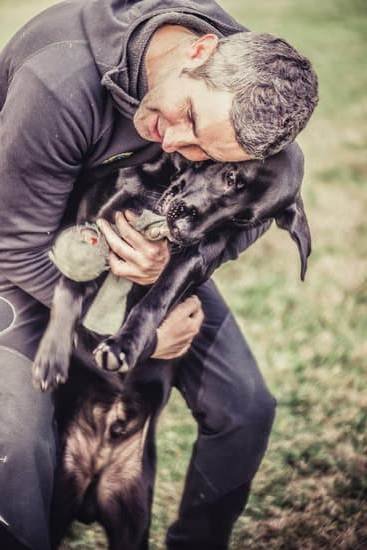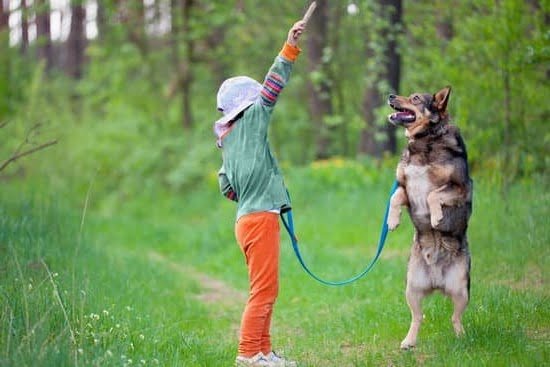When can a dog start agility training? Agility training for dogs is a fun and rewarding activity that not only provides physical exercise but also mental stimulation.
This article will explore the ideal age for starting agility training, the physical and mental readiness required, as well as assessing breed and individual dog factors to consider. It will also cover the importance of basic obedience training before agility, recommended equipment and safety measures, training techniques, tips for success, and encouraging confidence in your dog during agility training.
Agility training is a popular canine sport that involves navigating obstacles such as tunnels, weave poles, and jumps while being directed by their handler. It requires a combination of athleticism, obedience, and teamwork between the dog and their owner. To ensure a successful start to agility training, it’s important to consider various factors that will contribute to the overall experience for both you and your dog.
Before embarking on agility training with your dog, it’s essential to determine the ideal age for starting this activity. The physical and mental preparedness of your dog plays a crucial role in their ability to safely participate in agility training.
Additionally, understanding your dog’s breed and individual factors will help assess whether they are ready for this type of activity. This article will provide valuable insights into these considerations to help guide you in making an informed decision about when to start agility training with your dog.
The Ideal Age for Starting Agility Training in Dogs
When can a dog start agility training? One of the most common questions that dog owners have is about the ideal age to start agility training in their furry friends. While there is no set age that applies to all dogs, it is essential to consider several factors before beginning agility training with your pet.
Physical Development
The ideal age for starting agility training in dogs depends on their physical development. Most experts recommend waiting until a dog is at least 1 year old before introducing them to agility activities. This allows time for their bones and muscles to fully develop, reducing the risk of injuries during training.
Mental Readiness
In addition to physical readiness, it is crucial to consider the mental preparedness of your dog. They should have a strong foundational obedience training and be responsive to basic commands before starting agility training. Mental readiness also involves being able to focus and concentrate, which can vary from one dog to another.
Breed Considerations
It’s important to take into account the breed of your dog when determining the ideal age for starting agility training. Some breeds, such as Border Collies and Australian Shepherds, are known for excelling in agility due to their high energy levels and athleticism.
However, other breeds may not be physically or mentally suited for this type of activity at a young age. Consulting with a veterinarian or professional trainer can help assess whether your dog is ready for agility training based on their breed characteristics.
Physical and Mental Readiness for Agility Training
Agility training for dogs is a demanding and challenging activity that requires both physical and mental readiness. It’s important to consider these factors before starting your dog on agility training to ensure their health, safety, and overall enjoyment of the sport.
When can a dog start agility training? One of the key considerations is the age of your dog. Puppies should not start agility training until they are at least 12 months old.
This allows their bones, joints, and muscles to fully develop and mature, reducing the risk of injury during training or competition. However, this age may vary based on the breed and size of the dog, so it’s important to consult with a veterinarian to determine the appropriate age for your specific dog.
In addition to age, it’s essential to assess your dog’s physical fitness and mental readiness for agility training. Dogs participating in this sport need to have good overall health, strength, endurance, and flexibility. They should be free from any physical limitations or conditions that could impede their ability to perform agility exercises safely.
Furthermore, dogs should also possess a certain level of focus, drive, and attentiveness to follow commands quickly and accurately during training sessions. These mental attributes will contribute to their success in mastering agility obstacles and navigating courses effectively.
Assessing Breed and Individual Dog Factors
When considering starting agility training for your dog, it is important to take into account the breed and individual factors that may affect their readiness for this type of activity. Each dog is unique and may have different capabilities when it comes to agility training.
Breed Considerations
Certain breeds are naturally more inclined towards agility training due to their physical characteristics and high energy levels. Breeds such as Border Collies, Australian Shepherds, and Jack Russell Terriers are known for excelling in agility due to their athleticism and intelligence. On the other hand, brachycephalic breeds or those with short noses, such as Bulldogs or Pugs, may struggle with the physical demands of agility training.
Individual Dog Factors
Aside from breed considerations, it is essential to assess your dog’s individual characteristics and temperament. Some dogs may have a natural aptitude for agility and thrive in a competitive environment, while others may be more reserved or easily stressed by unfamiliar obstacles and fast-paced activities. It is crucial to consider your dog’s personality, confidence level, and willingness to learn new skills before starting agility training.
Consulting With a Professional
If you are unsure about whether your dog is suitable for agility training based on their breed or individual factors, it is advisable to consult with a professional trainer or veterinarian. They can provide valuable insight into your dog’s physical abilities, mental readiness, and overall suitability for agility training. Additionally, they can offer guidance on how to prepare your dog for this type of activity if they determine that they are not yet ready.
Importance of Basic Obedience Training Before Agility
Before starting agility training with your dog, it is essential to ensure that they have a strong foundation in basic obedience. This not only sets the stage for successful agility training but also ensures the safety and well-being of your dog during the process. Here are some key reasons why basic obedience training is important before starting agility:
- Safety: Basic obedience training teaches essential commands such as “sit,” “stay,” and “come,” which are crucial for maintaining control over your dog during agility exercises. These commands are also important for ensuring your dog’s safety, especially when navigating obstacles and performing jumps.
- Focus and Discipline: Obedience training helps build focus and discipline in your dog, which are essential for mastering agility skills. A dog that understands and obeys basic commands will be more receptive to learning new agility techniques and following instructions from their handler.
- Teamwork: Agility training requires a strong bond and teamwork between you and your dog. Basic obedience lays the groundwork for effective communication, trust, and cooperation between you and your furry companion, creating a solid foundation for successful agility training.
It is recommended to start basic obedience training as early as possible to set a strong foundation for agility training. This can begin as soon as you bring your puppy home or when you first adopt an adult dog. Consistent and positive reinforcement of basic commands will not only pave the way for successful agility training but also contribute to a well-behaved and responsive canine companion.
Ultimately, basic obedience serves as the building blocks for agility training, preparing your dog both mentally and physically for the exciting challenges ahead. By establishing a solid understanding of fundamental commands and behaviors, you can set the stage for a rewarding journey into the world of canine agility.
Recommended Equipment and Safety Measures for Agility Training
Agility training is a fun and rewarding way to bond with your dog while providing physical and mental stimulation. However, it’s important to prioritize safety when engaging in this activity with your furry friend. One essential piece of equipment for agility training is a properly fitted harness or collar. This will ensure that your dog is secure and comfortable while navigating through the obstacles.
In addition to a harness or collar, investing in quality agility-specific equipment such as tunnels, jumps, weave poles, and A-frames is crucial for creating a safe and enjoyable course for your dog. It’s important to carefully inspect all equipment before each training session to check for any signs of wear and tear that could potentially cause harm to your canine companion.
Moreover, safety measures should also be put in place to protect both you and your dog during agility training. Implementing clear boundaries and using positive reinforcement will provide a secure environment for your dog to learn and thrive. Finally, always remember to warm up your dog before each agility session to prevent injuries.
| Recommended Equipment | Safety Measures |
|---|---|
| Harness or collar | Establish clear boundaries |
| Tunnels, jumps, weave poles, A-frames | Use positive reinforcement |
| Regular inspection of equipment | Warm up before each session |
Training Techniques and Tips for Success
When can a dog start agility training is a common question among dog owners who want to get their furry friends involved in this exciting and challenging sport. The ideal age for starting agility training in dogs is around 1 year old.
This is when most dogs have fully developed physically and mentally, making them better equipped to handle the physical demands and learn the skills required for agility training. Starting too early can put unnecessary strain on a young dog’s developing joints and muscles, while starting too late may result in missed opportunities for early skill development.
It’s important to note that different breeds develop at different rates, so it’s best to consult with a veterinarian or professional trainer to determine the best age to start agility training for your specific breed. Additionally, assessing your individual dog’s temperament, energy level, and overall readiness is crucial in determining the right time to begin agility training.
Some dogs may be ready to start earlier than others, while some may need more time to mature before taking on the challenges of agility training.
When you do decide that your dog is ready for agility training, it’s essential to focus on building a strong foundation of basic obedience skills before diving into agility-specific training. This ensures that your dog has the discipline and control necessary to navigate obstacle courses safely and effectively.
In addition, introducing your dog to the equipment gradually and using positive reinforcement techniques will help build confidence and enthusiasm for agility training. With patience, consistency, and proper guidance, you can set your dog up for success in agility training.
Encouraging and Building Confidence in Your Dog During Agility Training
Building confidence in your dog during agility training is crucial for their success and enjoyment of the activity. Dogs, like humans, can experience fear or uncertainty when faced with new challenges, making it essential to provide them with the support and encouragement they need to overcome obstacles. Here are some techniques for encouraging and building confidence in your dog during agility training:
1. Positive Reinforcement: Utilize treats, praise, and other rewards to positively reinforce your dog’s successes during agility training. This will help build their confidence as they associate the activity with positive experiences.
2. Gradual Exposure: Introduce new agility obstacles gradually, allowing your dog to become comfortable with each one before moving on to more advanced challenges. This approach will prevent overwhelming your dog and give them the opportunity to gain confidence in their abilities.
3. Patience and Consistency: Be patient with your dog as they navigate the agility course, providing consistent guidance and reassurance throughout the training process. Your support will help instill confidence in your dog as they tackle each obstacle.
By implementing these strategies, you can help your dog develop the self-assurance needed to excel in agility training.
Additional Tips for Building Confidence
– Create a positive environment by keeping training sessions fun and stress-free.
– Recognize and celebrate even small achievements to boost your dog’s confidence.
– Incorporate play into agility training to make it an enjoyable experience for your dog.
– Stay attuned to your dog’s body language, stepping in if they appear anxious or overwhelmed.
– Consistently practice and reinforce learned skills outside of formal training sessions to enhance proficiency and build confidence.
Remember that every dog progresses at their own pace, so be patient and supportive as you work together to build their confidence throughout agility training.
Conclusion
In conclusion, agility training can be a fantastic way to build a strong bond with your dog. By starting at the right age and ensuring your dog is physically and mentally prepared, you can set the stage for a successful agility training journey.
It is crucial to consider your dog’s breed and individual factors, as well as ensure they have a solid foundation in basic obedience before diving into agility. Proper equipment and safety measures are essential, and using positive reinforcement techniques can help build confidence in your furry friend.
Remember that every dog is unique, so it’s important to tailor the training to fit their specific needs. Agility training can be a fun and rewarding experience for both you and your dog, and it has the potential to strengthen your relationship like no other activity can. So when can a dog start agility training?
As this article has highlighted, it all depends on various factors such as age, readiness, breed, and individual capabilities. With patience, consistency, and lots of love, you can enjoy the journey of agility training while strengthening the bond with your beloved canine companion.
Frequently Asked Questions
What Age Should Dogs Start Agility Training?
Dogs can start agility training at around 12 months old, once their growth plates have closed. This helps prevent any potential damage to their developing bones and joints.
How Do You Introduce a Puppy to Agility?
When introducing a puppy to agility, it’s important to start with basic foundation training such as obedience commands and socialization. Gradually introduce them to small obstacles and build up from there.
Can My Puppy Do Agility?
Yes, puppies can definitely do agility as long as it is done in a safe and appropriate manner. It’s important to consider their physical and mental development, and start with simple, low-impact obstacles.

Welcome to the blog! I am a professional dog trainer and have been working with dogs for many years. In this blog, I will be discussing various topics related to dog training, including tips, tricks, and advice. I hope you find this information helpful and informative. Thanks for reading!





